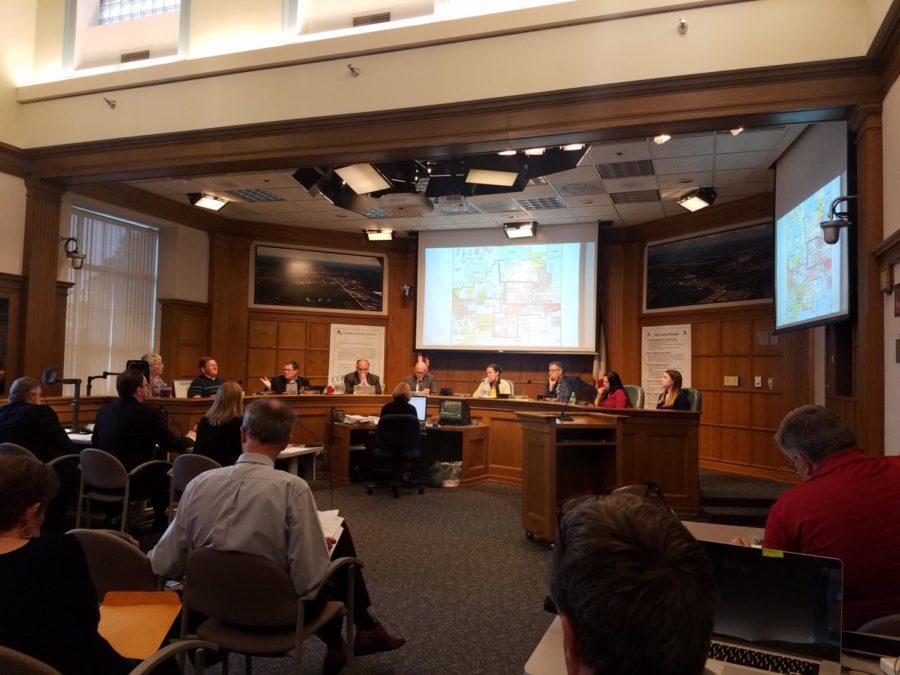- App Content
- App Content / News
- News
- News / Politics And Administration
- News / Politics And Administration / City
City Council holds workshop in downtown investment
June 19, 2018
Before the public gave their own vision and recommendations for the downtown area, the Ames Economic Vitality Committee gave their Main Street Cultural District report over a study they started last year to better understand the public perception of downtown Ames.
At Tuesday’s City Council meeting, the City Council decided to push back their review and direction regarding the November 2017 staff report, which addresses possible locations for a public plaza, stormwater management requirements. The City Council did discuss residential parking standards and possible incentives to entice investment but made no final determinations.
A similar workshop will be held next month encouraging investment in Campustown.
The City Council also passed an ordinance unanimously to give street names to a portion of East Ames. This area was having issues getting their mail following the the annexation of the area that was formerly part of Nevada.
“We have a great downtown,” said Cindy Hicks, executive director of the Main Street Cultural District. “Our community could not have asked for a more dedicated group of representatives to advocate for downtown.”
Hicks said the study, along with the commitment of the City Council, had potential to impact and grow the downtown area.
Susan Bradbury, member of the Economic Vitality Committee and professor of community and regional planning at Iowa State, gave the breakdown of the report.
“We need more housing downtown,” Bradbury said. “That is our weakest part of downtown.”
This housing, Bradbury said, is keeping potential people from living in Ames.
“The research tends to show that housing in the downtown is not what people desire,” Bradbury said. “They don’t want to live like students anymore. They tend to work in Ames but live in places like Ankeny and Des Moines, where they can get the housing they desire.”
Based on current zoning standards, their report showed 175 residential units, defined as a one to two bedroom apartment, could be built in the downtown area. Eighty-eight percent of respondents in the survey agreed with this decision.
Respondents also criticised the parking situation downtown, the amount of food and business options, store hours and the landscaping, but said they liked the character, feel, history and atmosphere of the downtown area.
“We have heard every single parking complaint out there,” Bradbury said.
Based on the report, Bradbury recommended a comprehensive parking study, the last of which was in 2009. She also requested the city revisit building codes, specifically a requirement for reserved parking spaces within 300 feet of a residential unit.
Members of the public largely agreed with the complaints about parking.
“We have seen exponential growth in the employment downtown,” said Ames business owner Kristin Roach. “We are very happy about that. However, since the 2009 study, the number of people working downtown has doubled. That is why we need the parking study for downtown. There is nowhere near 1,000 parking spaces for employees, residents or shoppers.”
Curt Friedrich, business owner in the downtown area, mirrored many of these concerns and proposed three solutions if his realty business were to expand in Ames.
He first wanted to get rid of the floor area ratio which says for every one square foot of parking space there needs to be one square foot of store/office space.
“We have a 23,000 square foot lot, we have to build a 23,000 square foot office space,” Friedrich said. “Office users don’t want multiple stories, they want space on the main story.”
He also wanted to get rid of the two story minimum on stores in the downtown area.
“i understand the reason based on looks, but it is not practical,” he said. “People don’t want multi-level offices.”
Finally, Friedrich wanted more incentives for downtown businesses.
“We want more jobs and people downtown to enliven the business life downtown. That means more office[s]. We need office[s] to be a part of [the] URA, or urban revitalization area. When we tear down a six-plex, we could lose equity in our property but under the URA get a tax abatement.”
Considering public recommendations, a motion was passed unanimously to have city staff look into and report on how expensive the parking study would be and look for a short term solution based on public recommendations.
Parking changes are already set for July 1 when differential metering will be implemented downtown. This means areas on Main Street will have shorter term, higher cost parking meters while further streets will have meters that are cheaper and have longer capacities.
One solution proposed by the public was to build a parking structure downtown.
“We shouldn’t vote on any solutions until we can figure out our future vision for the downtown area,” said Ward Two representative Tim Gartin. “I don’t know how we can move forward with something as aggressive as a parking ramp if we are talking about the status quo downtown, but if we have a vision for growing downtown than there is no other alternative than a parking structure.”
Ward One representative Gloria Betcher agreed, saying parking structures might be going too far.
“Parking ramps are very expensive, and car usage is going down,” Betcher said. “Even self driving cars give us reason to question the necessity of parking ramps. We need to ask ourselves, do we have a parking problem or a parking management problem?”







